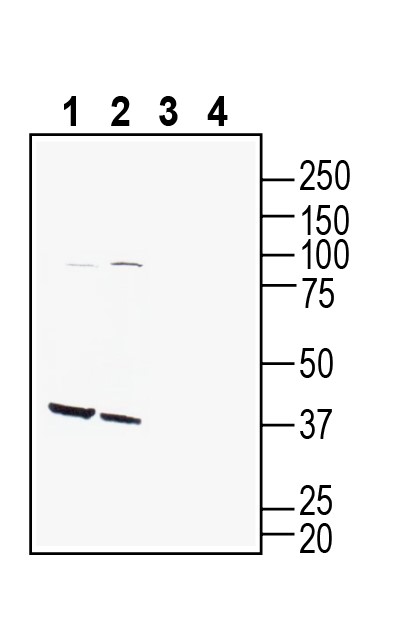Overview
Application key:
Species reactivity key:
Specifications
- Peptide (C)APVHRDWRVHLALD, corresponding to amino acid residues 291 - 304 of mouse GPR142 (Accession Q7TQN9). Extracellular, 3rd loop.
Applications
 Western blot analysis of mouse pancreas lysate (lanes 1 and 3) and rat pancreas lysate (lanes 2 and 4):1-2. Anti-GPR142 (extracellular) Antibody (#AGR-082), (1:400).
Western blot analysis of mouse pancreas lysate (lanes 1 and 3) and rat pancreas lysate (lanes 2 and 4):1-2. Anti-GPR142 (extracellular) Antibody (#AGR-082), (1:400).
3-4. Anti-GPR142 (extracellular) Antibody, preincubated with GPR142 (extracellular) Blocking Peptide (BLP-GR082). Western blot analysis of mouse brain lysate (lanes 1 and 3) and rat brain lysate (lanes 2 and 4):1-2. Anti-GPR142 (extracellular) Antibody (#AGR-082), (1:400).
Western blot analysis of mouse brain lysate (lanes 1 and 3) and rat brain lysate (lanes 2 and 4):1-2. Anti-GPR142 (extracellular) Antibody (#AGR-082), (1:400).
3-4. Anti-GPR142 (extracellular) Antibody, preincubated with GPR142 (extracellular) Blocking Peptide (BLP-GR082). Western blot analysis of human THP-1 monocytic leukemia cell line lysate (lanes 1 and 4), human Jurkat T-cell leukemia cell line lysate (lanes 2 and 5) and human SH-SY5Y neuroblastoma cell line lysate (lanes 3 and 6):1-3. Anti-GPR142 (extracellular) Antibody (#AGR-082), (1:400).
Western blot analysis of human THP-1 monocytic leukemia cell line lysate (lanes 1 and 4), human Jurkat T-cell leukemia cell line lysate (lanes 2 and 5) and human SH-SY5Y neuroblastoma cell line lysate (lanes 3 and 6):1-3. Anti-GPR142 (extracellular) Antibody (#AGR-082), (1:400).
4-6. Anti-GPR142 (extracellular) Antibody, preincubated with GPR142 (extracellular) Blocking Peptide (BLP-GR082).
Scientific Background
G-protein-coupled receptors (GPCRs) are the largest family of membrane proteins and mediate a myriad of physiological and pathophysiological signaling processes. Of these receptors, all are seven membrane spanning receptors but not all are G protein binding but it is convenient to refer to the receptors as GPCRs1.
The GPR142 is a GPCR selectively activated by aromatic amino acids and share 33% amino acid identity with GPR139. L-tryptophan representing one of the most potent ligands, having an EC50 values of 0.2 – 1 mM2. GPR142 is expressed in both rodent and human pancreatic beta cells. Moreover, it was found to be implicated in the regulation of insulin, thereby having a crucial role in Type II diabetes management3.
Moreover, GPR142 is highly expressed in immune cells and its ligand L-tryptophan and metabolite serotonin are known to take part in inflammation process. It was shown that mice lacking GPR142 gene are more resilient to anti-type II collagen (CII) antibody-induced arthritis however the exact mechanism is currently unknown4.
